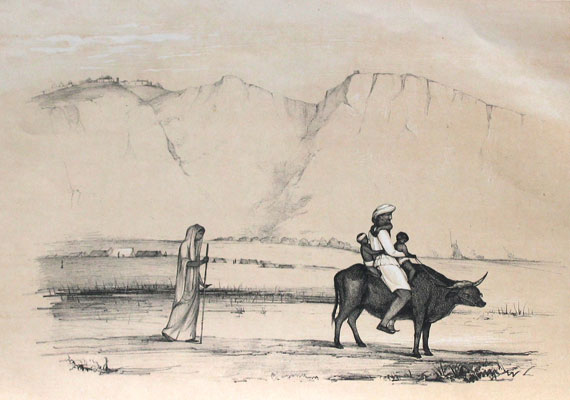
"A Hindoo Family on a Pilgrimage to the Holy Lake of Poshkur"
This plate is combined out of three different scenes in intricate spatial arrangement: in the foreground, a Hindu family is seen on its pilgrimage to Poshkur, behind them is a temporary gypsy settlement, and on the far mountain ridge, the shape of the Fortress of Tara Gurh in Ajmere is still recognizable.
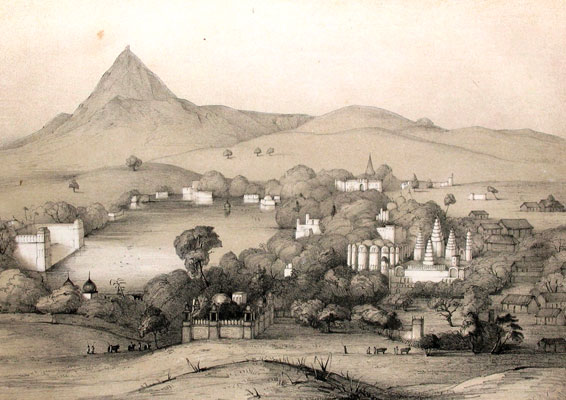
"Poshkur"
The pilgrimage site of Poshkur or Pushkar (today belonging of the federal state of Rajasthan), set around a holy lake with a multitude of shrines. Hindus that a ritual bath in this lake, especially at full moon, has the power to wash off their sins.
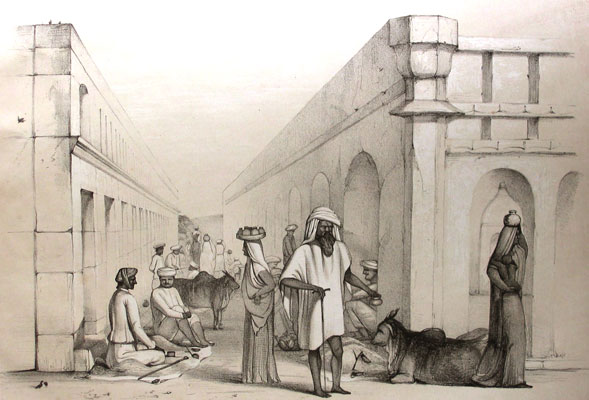
"Bazaar, or Market Scene"
Another picture that is composed from multiple scenic observations – here on the market of Pushkar: at the center, we see a fakir bent over a stick and collecting alms. To his right hand side, a woman bearing a child, balancing a water jar on her head. On the left side of the picture there is a scene that must have been particularly amusing for the author: a wheat merchant squatting on the ground next to an equally squatting traveler from Delhi engaged in a lively conversation. This chat is suddenly interrupted by the naggings of an old market-woman stepping up in front of them.
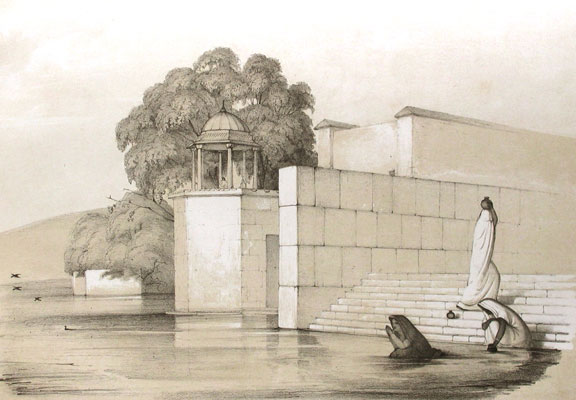
"Scene on the Lake of Poshkur"
The separated points of access to the holy lake are flanked by small, temple-like buildings where Brahmans are soliciting a kind of entrance fees. One of the three women we see is engaged in a morning prayer while the other two use the lake as a resource for drinking and washing water.
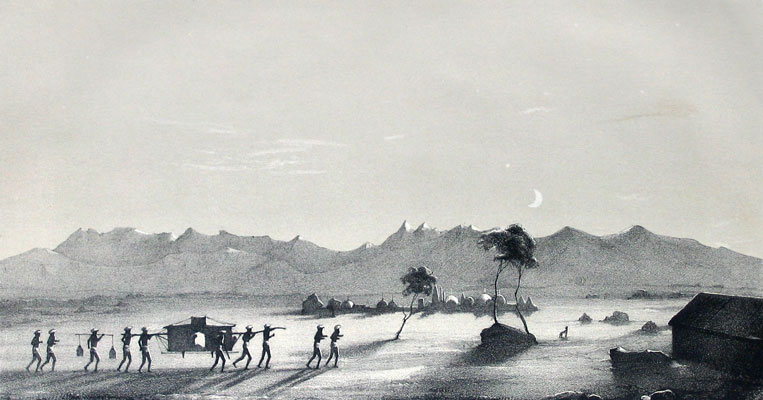
"Dawk Travelling"
Dawk or Dak was the term for the early Anglo-Indian transport system through which postal goods and travelers were carried from station to station by groups of drudges in nocturnal relays races.
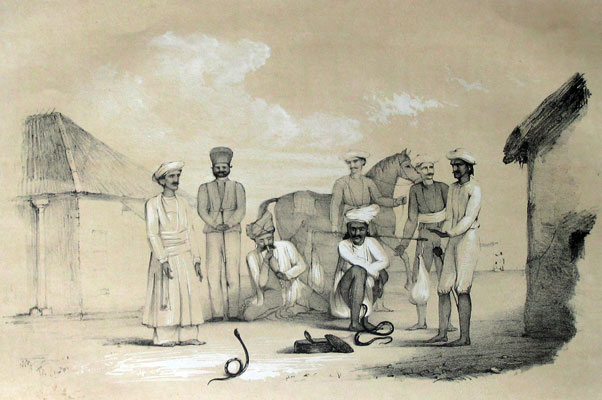
"Snake Charmers"
A duet of snake charmers, one playing the flute, another to watch over the safety of the act, is framed by a group of bystanders – apparently employed in this picture to illustrate the Indian caste system. The outer margin is taken by a Hindu servant (right) responsible for wardrobe, and by a Muslim cupbearer. Beside the latter is a khulassee in uniform looking after household matters, beside him another servant, but of a lower rank.
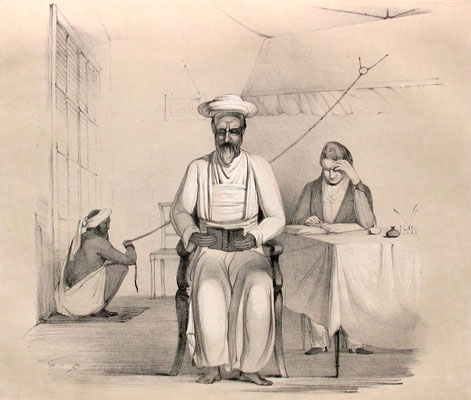
"A Moonshee"
A moonshee, a Muslim language master teaching the Persian parts of Hindustani, is preparing a British language student for his exam. In the background, a kuli, one of the lowest-ranking servants, is holding a big fan. Shutters are closed to keep out the heat of noontime.
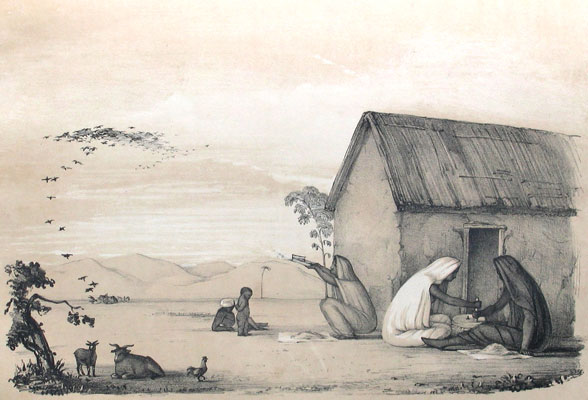
"Two Women Grinding at a Mill"
Rechts im Bild sind gerade im Schatteneiner Hütte zwei Frauen dabei, mit einer Steinmühle den Tagesbedarf an Hülsenfrüchten zu mahlen. Daneben ist zu sehen, wie durch das Schütteln in einem schaufelartigen Korbbehälter die Spreu vom Korn getrennt wird, das kürzlich von dem Ochsen zertreten wurde, der sich nun wiederum nach getaner Arbeit im unteren Bildrand unter dem Schatten eines Baumes ausruht. Eine weitere Form der Separation findet links im Bildhintergrund statt, wo Raubvögel und Aasgeier das Fleisch eines Tierkadavers von den Knochen lösen.
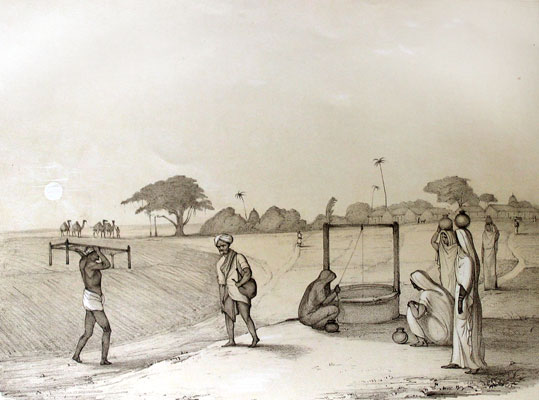
"Women Drawing Water from a Well at Even"
To the right two women in the shadow of a hut are grinding their daily ration of leguminous plants with a stone mill. Beside them, the chaff is separated from the wheat that was already treaded by an ox now resting against a tree – by the shaking movement of a shovel-like basket. Another kind of separation is seen in the background on the left, where birds of prey and vultures are disemboweling an animal cadaver.
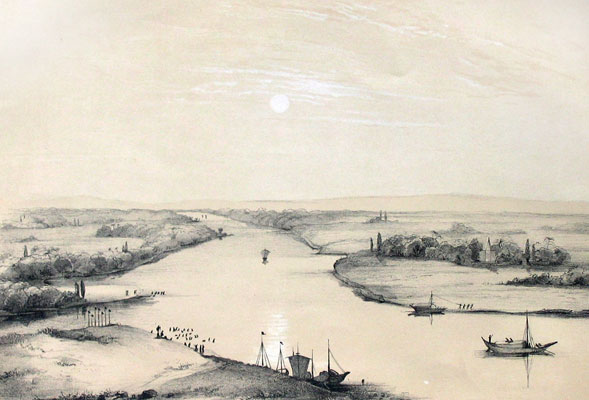
"Confluence of the Ganges and Jumna at Allahabad"
The place where the Rivers Jumna / Yamuna and Ganges meet is revered by the Hindu as one of their most sacred. The many people bathing there in this illustration give vivid testimony of it.
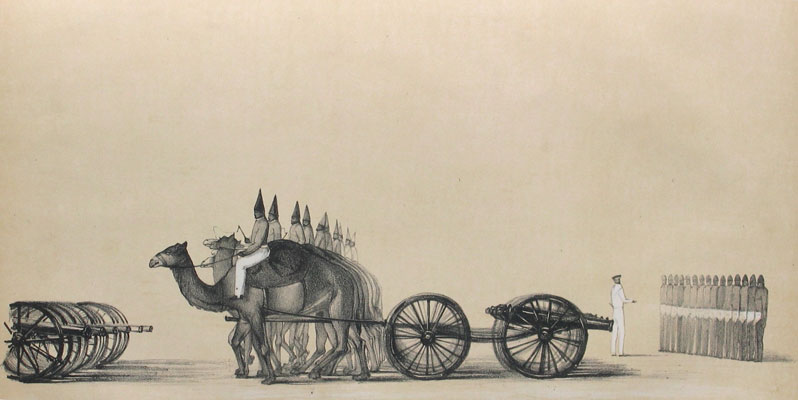
"A Camel Battery"
Despite their latent obstinacy, camels were used in the army of the East India Company not only as carriers and for riding, but also for pulling mounted cannons. On the right we see how the Sepoys, native Muslim soldiers forced to share the same physique, were drilled after the model of British recruit training. (The countrywide upheaval of the Sepoys in 1857, Die landesweite Meuterei der Sepoys 1857, quickly silenced by the British who were supported by Hindu troops, marked the end of the H.E.I.C.’s reign. All their possessions were passed to the Crown, the land was formally declared a British colony.)
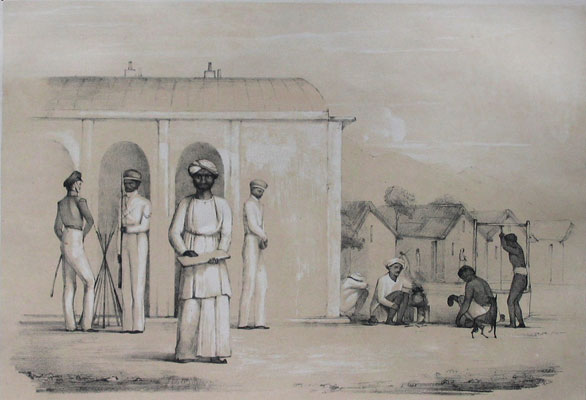
"Scene near a Hospital"
In the surroundings of a military hospital, from left to right: an Indian officer reporting to his British superior, a native assistant physician, Im Umkreis eines Militärlazaretts sind zu sehen von links nach rechts: ein indischer Offizier holding a file in his hands, and a group of servants preparing themselves to have breakfast by ritual washings. The breakfast is prepared on a small earthen stove called Chulha. (http://www.geda.org.in/systems/sd_impchl_typchulha.htm).
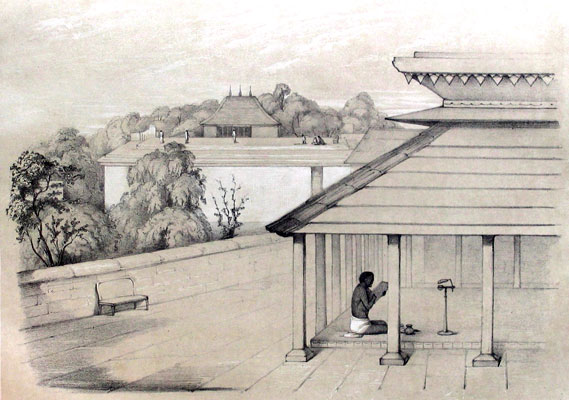
"View from the Fort at Bhurtopore"
During the evening and morning hours, the roofs are the mostly visited parts of Indian houses. From his vantage point, the Fortress of Bhurtopore (Bharatpur), that had been taken in 1826 against the grim resistance of the native troops by the British and was a heavily contested place in the first Sikh War, the author observes the adjacent buildings. On the roof of the neighboring house, he spots one of the inhabitants writing on a blackboard with a piece of chalk. In front of him there is a high, wrought-iron oil lamp. These lamps’ slags were often used as make-up for the eyes.
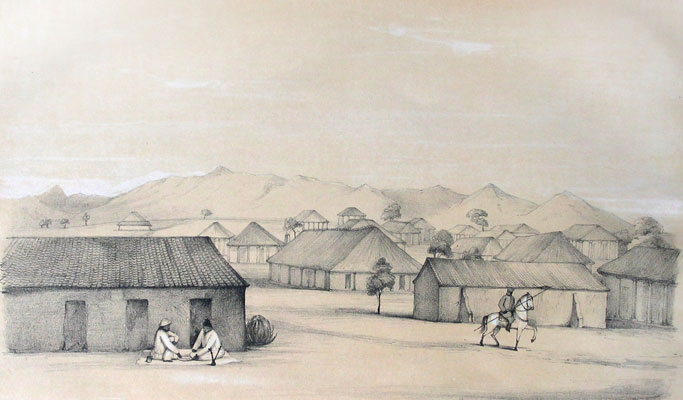
"A Cantonment"
The author regrets to have sketched a rather untypical example of an H.E.I.C. military training camp. Normally the built structures on such facilities would look less regularly arranged. He also cautions the reader to remark that the rooms in Indian bungalows are usually loftier than their British counterparts.
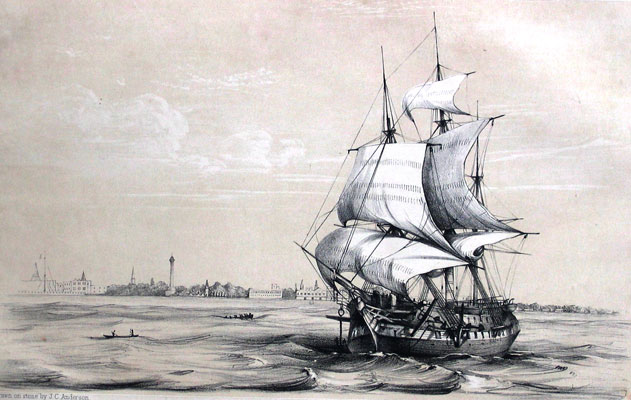
"Madras"
The view to Madras from the sea is rather monotonous, writes the author in his account. He described the lack of waves that could have made it through the narrow patch of land on the shore. Left of the ship there are some catamarans with fishermen on board.
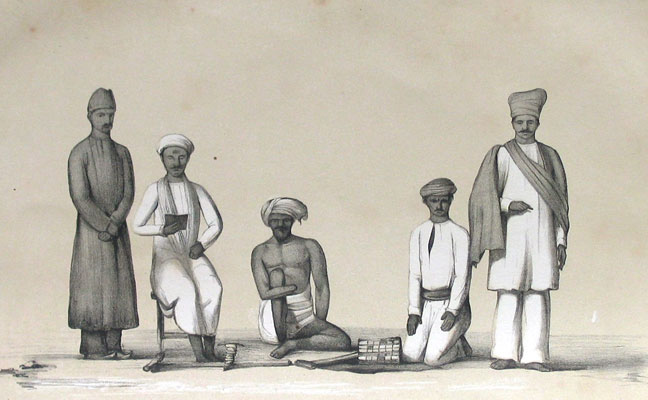
"A Group Of Characters"
On the left hand side a thanadar, a civil servant responsible to the British administration, beside him a pundit (or pandit), who – as a counterpart to the moonshee – did not only serve as teacher for the Hinduist elements of the Hindustani language, but was also in high esteem as a spritual guide; next to him a poor man punished for espionage by the Muslim sharija by the amputation of his arm and leg, now earning a meager living as a beggar; furthermore, a Hindu garment salesman, and, finally on the far right, a rich Parsi merchant, adherent to a Zoroastrian fire cult, who like all of his fellow cult followers, lives separated from his Hindu and Muslim neighbors.
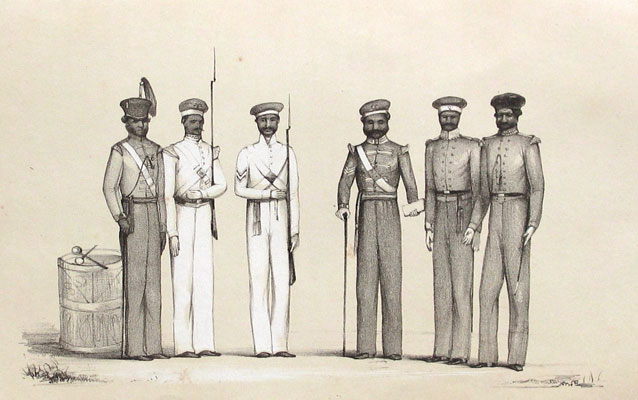
"A Group Of Native Soldiers"
Next to the regiment’s drummer, we see, arranged in a row, the various military ranks that were open for the native soldiers, the Sepoys, in the service of the Anglo-Indian colonial army.
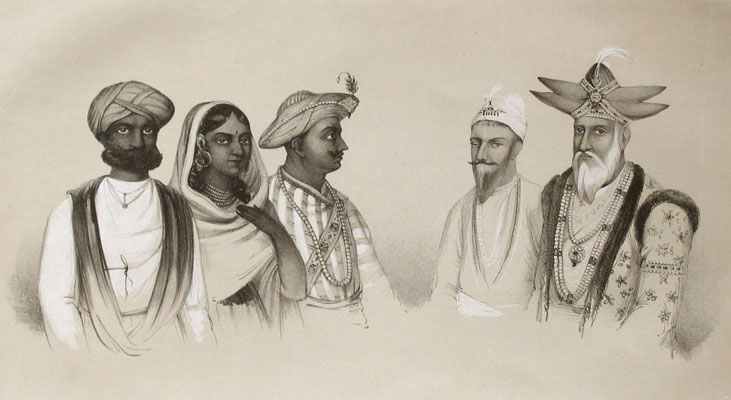
"Five Portraits"
On the left side a criminal adhering to the faith in Kali, the goddess of destruction. Pretending to be friendly and trustworthy, it is said, he is leading travelers astray to then murder them perfidiously. Beside him, an Indian couple of noble descent, accompanied by Ranjit Singh, a legendary ruler of the Punjabi Sikh. On the far right the ruler of Delhi. The author wishes to emphasize that he cannot vouch for the reliability of some of the portraits since they did not originate in his own design.
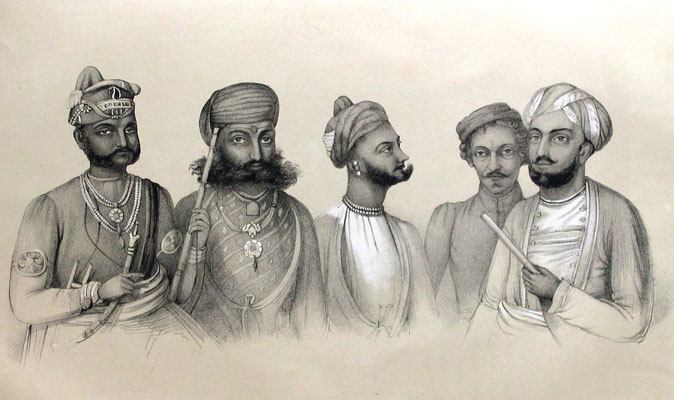
"Five Portraits"
On the left a rajah, an Indian prince; beside him two Indian feudal lords, and a Hindu miniature painter, on the far right Akhbar Khan: „A name too well known to require mention here“, is the lapidary comment below (the legendary Afghan resistance fight, son of Dost Mohammed Khan who was dethroned by the British, brought painful defeat to the Empire and the troops of the H.E.I.C. in the course of lacerating guerrilla fights during the First Afghan War, taking away their nimbus of invincibility in the Asian region).
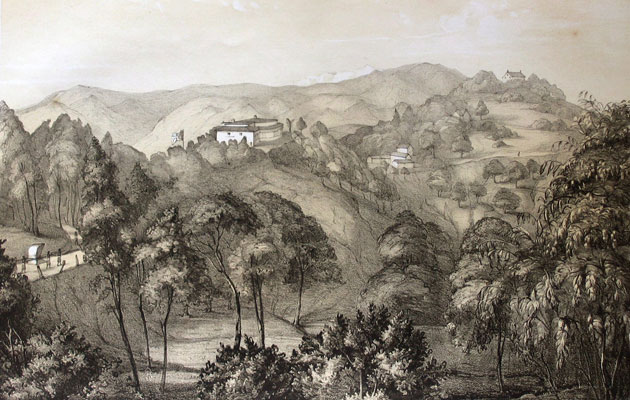
"Lord Hardinge’s Residence at Simlah"
Simlah in the Himalayas was the location of a favorite sanatorium of the Anglo-Indian Colonial Army. According to the author, the route to this place was not without its dangers.
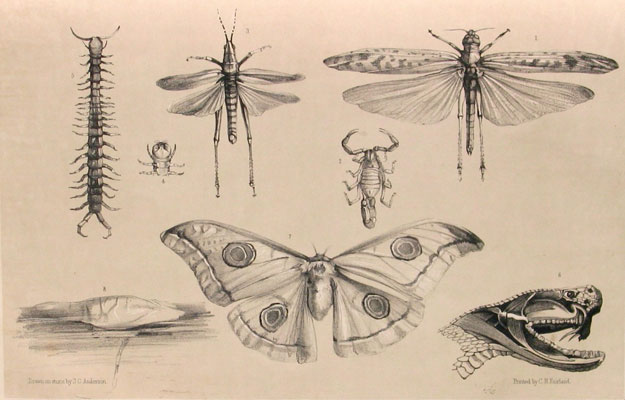
"Insects, etc."
A pictorial parade of unwelcome animals from the diverse climate zones of India: 1) locust; 2) scorpion; 3) blue locust; 4/5) centipede; 6) snake; 7) butterfly of the Indian silkworm; 8) bluebottle or Portuguese Man-of-War (Physalia physalis, a poisonous jellyfish).
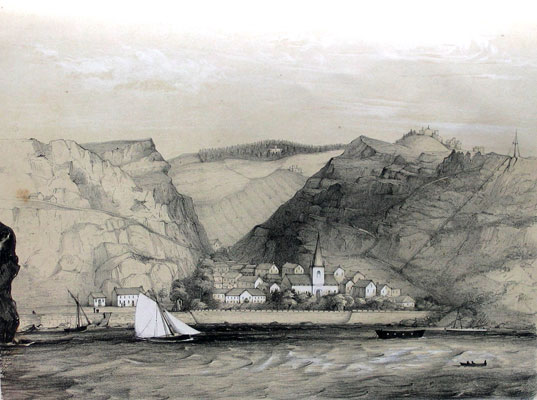
"James Town, St. Helena"
Jamestown on the Island of St. Helena was an important H.E.I.C. freshwater post on the sea passage to India.